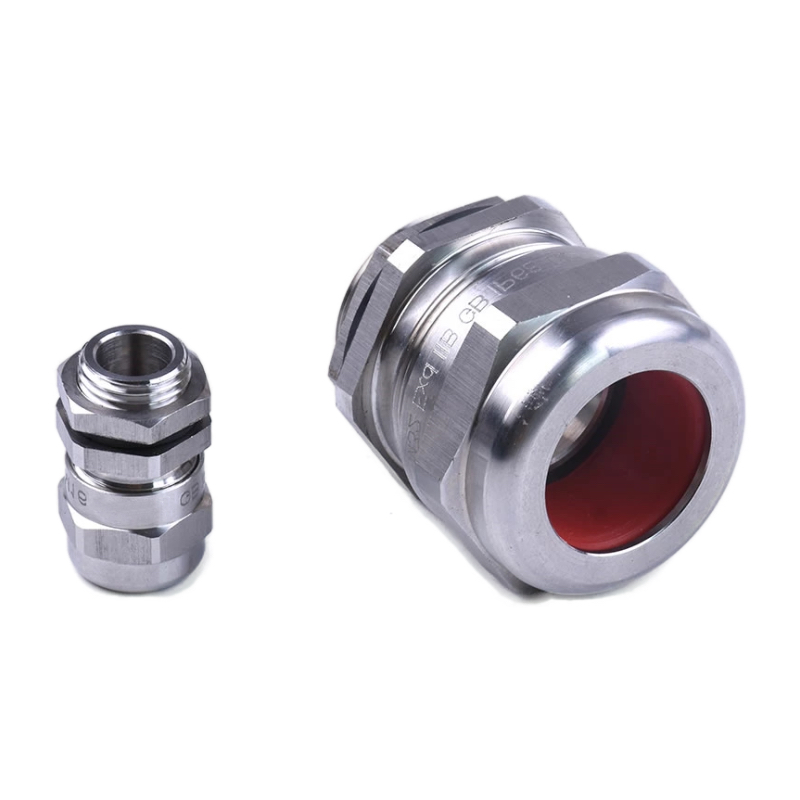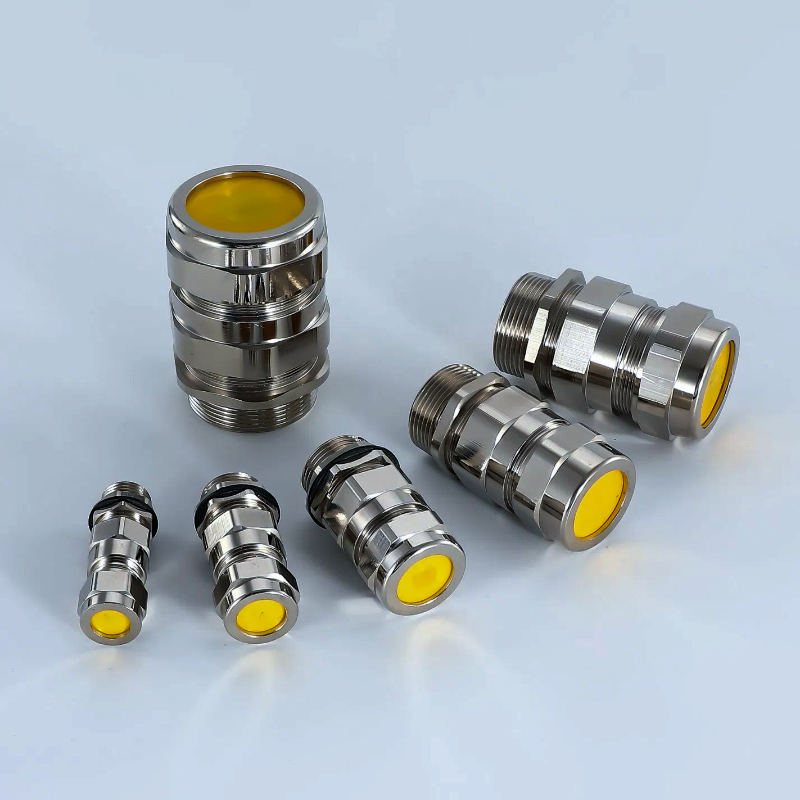Gas leakage in hazardous environments can be catastrophic. A single failed seal in a petrochemical facility or offshore platform can trigger explosions, environmental disasters, and loss of life. Yet many engineers still struggle with achieving reliable gas-tight sealing in cable entry applications.
Gas-tight sealing with barrier glands requires proper compound selection, precise installation techniques, and regular integrity testing to prevent gas migration through cable cores and maintain hazardous area safety classifications. These specialized glands create multiple barriers against gas penetration while maintaining electrical continuity and mechanical protection.
Just three months ago, I received an emergency call from Hassan, operations manager at a natural gas processing facility in Qatar. During routine safety inspections, they discovered gas traces in their electrical control room – a potentially explosive situation. The culprit? Improperly sealed cable glands allowing gas migration through multi-core cable interstices. We had to mobilize our technical team within 24 hours to prevent a complete facility shutdown 😰
Table of Contents
- What Are Barrier Cable Glands and Why Are They Critical?
- How Do Gas-Tight Sealing Mechanisms Work?
- What Are the Key Components for Effective Gas Sealing?
- How to Select the Right Barrier Gland for Your Application?
- What Are Proper Installation and Testing Procedures?
- FAQs About Gas-Tight Barrier Glands
What Are Barrier Cable Glands and Why Are They Critical?
Understanding barrier glands is essential for anyone working in hazardous area installations where gas containment is paramount.
Barrier cable glands are specialized sealing devices that prevent gas migration through cable cores and interstices, maintaining hazardous area classifications by creating multiple physical barriers against explosive gas penetration. They’re mandatory in Zone 1 and Zone 2 hazardous areas1 where flammable gases may be present.
The Science Behind Gas Migration
Gas migration occurs through several pathways in standard cable installations:
- Cable core interstices: Microscopic gaps between individual conductors
- Conductor stranding spaces: Air pockets within stranded wire construction
- Sheath permeability: Molecular diffusion through cable jacket materials
- Interface gaps: Clearances between cable and gland sealing elements
Regulatory Requirements
International standards mandate gas-tight sealing in specific applications:
| Standard | Application Scope | Gas-Tight Requirements |
|---|---|---|
| IEC 60079-14 | Hazardous area installations | Mandatory for Zone 1, recommended Zone 2 |
| ATEX 2014/34/EU | European explosive atmospheres | Required for Category 1 and 2 equipment |
| NEC Article 501 | US hazardous locations | Class I Division 1 and 2 installations |
| API RP 500 | Petroleum industry | Upstream and downstream facilities |
Consequences of Inadequate Sealing
The risks of gas migration extend far beyond regulatory compliance:
- Explosion hazards: Accumulated gases can reach explosive concentrations
- Equipment damage: Corrosive gases attack electrical components
- Environmental contamination: Toxic gas release into safe areas
- Operational shutdowns: Safety systems trigger facility-wide stops
- Legal liability: Non-compliance with safety regulations
At Bepto, we’ve witnessed the devastating consequences of inadequate gas sealing. That’s why our barrier glands undergo rigorous testing to IEC 60079-1 standards, ensuring reliable performance in the most demanding applications.
How Do Gas-Tight Sealing Mechanisms Work?
The engineering principles behind effective gas-tight sealing involve multiple complementary technologies working in concert.
Gas-tight sealing mechanisms combine elastomeric compression seals, sealing compounds that penetrate cable interstices, and mechanical barriers that physically block gas pathways. The most effective systems use redundant sealing principles to ensure reliability even if one mechanism fails.
Primary Sealing Technologies
Compression Sealing Systems
Traditional compression seals work by deforming elastomeric materials around the cable outer sheath:
- Advantages: Simple, reliable, cost-effective
- Limitations: Cannot seal cable core interstices
- Applications: Basic environmental sealing, non-hazardous areas
Compound Injection Systems
Advanced barrier glands inject sealing compounds into cable interstices:
- Mechanism: Low-viscosity compounds penetrate conductor gaps
- Curing process: Compounds polymerize2 to form permanent barriers
- Effectiveness: Blocks microscopic gas pathways
- Durability: Maintains seal integrity for 20+ years
Mechanical Barrier Systems
Physical barriers prevent gas flow through alternative pathways:
- Solid barriers: Metal or polymer discs block cable cores
- Expandable barriers: Materials that swell when exposed to gases
- Combination systems: Multiple barrier types for redundancy
Sealing Compound Chemistry
The effectiveness of barrier glands depends heavily on sealing compound formulation:
| Compound Type | Key Properties | Typical Applications |
|---|---|---|
| Polyurethane | Excellent adhesion, chemical resistance | General industrial, marine |
| Silicone | Temperature stability, flexibility | High-temperature applications |
| Epoxy | Superior mechanical strength, durability | Permanent installations |
| Hybrid formulations | Optimized for specific gas types | Specialized applications |
Hassan’s Qatar Facility: A Case Study in Compound Selection
Remember Hassan’s gas processing facility? Here’s how we solved their critical sealing challenge:
Problem Analysis:
- Natural gas (methane) migration through 24-core control cables
- High-pressure environment (15 bar operating pressure)
- Temperature range: -10°C to +60°C
- Hydrogen sulfide contamination requiring chemical resistance
Solution Implementation:
- Selected hybrid polyurethane-silicone compound for optimal gas resistance
- Implemented dual-barrier system with primary and secondary seals
- Used pressure-injection technique for complete interstice penetration
- Installed pressure monitoring system for ongoing seal integrity verification
Results:
- Zero gas detection after 72-hour pressure testing
- Facility returned to full operation within 48 hours
- Follow-up testing at 6 months confirmed continued seal integrity
- Client implemented our barrier glands across entire facility (200+ units)
What Are the Key Components for Effective Gas Sealing?
Achieving reliable gas-tight sealing requires understanding and optimizing each component in the sealing system.
Effective gas sealing depends on proper gland body design, appropriate sealing compound selection, compatible cable construction, and precise installation procedures. Each component must be optimized for the specific gas types, pressures, and environmental conditions present in your application.
Gland Body Design Considerations
Material Selection
The gland body material directly impacts sealing performance:
- Brass (CW617N): Excellent machinability, good corrosion resistance
- Stainless Steel 316L: Superior chemical resistance, marine applications
- Aluminum: Lightweight, good for non-corrosive environments
- Specialized alloys: Hastelloy, Inconel for extreme chemical exposure
Thread Design and Tolerances
Precision threading ensures proper seal compression:
- Thread pitch accuracy: ±0.05mm tolerance for consistent compression
- Surface finish: Ra 1.6μm maximum for optimal seal contact
- Thread engagement: Minimum 5 full threads for mechanical integrity
Sealing Element Specifications
Primary Seal Requirements
- Material compatibility: Must resist target gas types
- Compression ratio: 15-25% for optimal sealing without damage
- Temperature stability: Maintain properties across operating range
- Chemical resistance: No degradation from process chemicals
Secondary Seal Characteristics
- Redundancy function: Independent sealing mechanism
- Failure indication: Visual or measurable seal compromise detection
- Maintenance access: Replaceable without cable disconnection
- Long-term stability: 20+ year service life expectation
Cable Construction Compatibility
Conductor Configuration Impact
Different cable constructions present varying sealing challenges:
| Cable Type | Sealing Difficulty | Special Requirements |
|---|---|---|
| Solid conductors | Low | Standard compression sealing |
| Stranded conductors | Medium | Compound penetration needed |
| Flexible/fine strand | High | Specialized low-viscosity compounds |
| Armored cables | Very High | Multi-stage sealing process |
Sheath Material Considerations
Cable sheath materials affect compound adhesion and compatibility:
- PVC sheaths: Good compound adhesion, moderate gas permeability
- XLPE sheaths: Excellent electrical properties, requires primer for adhesion
- PUR sheaths: Superior flexibility, chemical compatibility critical
- Fluoropolymer sheaths: Exceptional chemical resistance, difficult adhesion
Quality Control and Testing Components
Pressure Testing Equipment
- Test pressure capability: 1.5x maximum operating pressure
- Pressure decay monitoring: 0.1 bar resolution minimum
- Temperature compensation: Accurate readings across temperature range
- Data logging: Permanent record of test results
Gas Detection Systems
- Sensitivity levels: Parts per million detection capability
- Gas-specific sensors: Optimized for target gas types
- Response time: Rapid detection for safety applications
- Calibration stability: Consistent accuracy over time
How to Select the Right Barrier Gland for Your Application?
Proper barrier gland selection requires systematic analysis of multiple technical and environmental factors.
Select barrier glands based on gas type and concentration, operating pressure and temperature, cable construction and size, environmental exposure conditions, and regulatory compliance requirements. The selection process must consider both normal operating conditions and potential upset scenarios.
Step-by-Step Selection Framework
Phase 1: Hazard Analysis
- Gas identification: Determine specific gas types present
- Concentration assessment: Maximum expected gas concentrations
- Pressure evaluation: Operating and maximum pressures
- Temperature mapping: Normal and extreme temperature ranges
- Duration analysis: Continuous vs. intermittent exposure
Phase 2: Performance Requirements
- Sealing effectiveness: Required leak rates (typically <10⁻⁶ mbar·l/s)3
- Pressure rating: Safety factor above maximum operating pressure
- Temperature capability: Performance across full temperature range
- Chemical compatibility: Resistance to all process chemicals
- Service life: Expected maintenance intervals and replacement cycles
Phase 3: Installation Constraints
- Space limitations: Available clearance for gland installation
- Access requirements: Maintenance and testing accessibility
- Cable routing: Entry angle and bend radius considerations
- Panel thickness: Gland length and thread engagement
- Installation environment: Clean room vs. field conditions
Application-Specific Selection Guidelines
Petrochemical Facilities
- Primary gases: Methane, ethane, propane, hydrogen sulfide
- Recommended materials: 316L stainless steel, Hastelloy for H₂S
- Sealing compounds: Fluoroelastomer-based for chemical resistance
- Testing frequency: Monthly pressure testing, annual compound inspection
Offshore Platforms
- Environmental challenges: Saltwater exposure, temperature cycling
- Material requirements: Super duplex stainless steel, marine-grade compounds
- Vibration resistance: Enhanced mechanical design for wave action
- Accessibility: Remote monitoring and diagnostic capabilities
Natural Gas Processing
- High-pressure requirements: Up to 100 bar operating pressure
- Rapid gas expansion: Joule-Thomson cooling effects4
- Compound selection: Low-temperature flexibility essential
- Safety systems: Integration with gas detection and shutdown systems
Cost-Benefit Analysis Framework
When evaluating barrier gland options, consider total cost of ownership:
| Cost Factor | Initial Impact | Long-term Impact |
|---|---|---|
| Purchase price | High | Low |
| Installation labor | Medium | Low |
| Testing and commissioning | Medium | Medium |
| Maintenance requirements | Low | High |
| Failure consequences | Low | Very High |
| Regulatory compliance | Medium | High |
What Are Proper Installation and Testing Procedures?
Even the highest-quality barrier glands will fail without proper installation and testing procedures.
Proper installation requires surface preparation, precise compound application, controlled curing conditions, and comprehensive pressure testing to verify gas-tight integrity. Each step must be documented for regulatory compliance and future maintenance reference.
Pre-Installation Preparation
Cable Preparation
- Cable inspection: Check for damage, contamination, or defects
- Dimension verification: Confirm cable diameter within gland specifications
- Sheath cleaning: Remove all contaminants using appropriate solvents
- Core preparation: Strip and prepare individual conductors as required
- Moisture removal: Ensure complete dryness before compound application
Environmental Conditions
Optimal installation conditions are critical for compound curing:
- Temperature range: 15-25°C for most compounds
- Humidity control: <60% relative humidity
- Contamination prevention: Clean, dust-free environment
- Ventilation: Adequate air circulation for solvent evaporation
Installation Sequence
Step 1: Gland Body Assembly
- Apply thread sealant to gland threads
- Install gland body with proper torque (typically 40-60 Nm)
- Verify thread engagement and alignment
- Check for proper panel contact and sealing
Step 2: Cable Installation
- Route cable through gland body
- Position cable for optimal compound access
- Install temporary cable support if required
- Verify cable position and strain relief
Step 3: Compound Application
- Mixing: Follow manufacturer’s ratios precisely
- Injection: Use pressure injection for complete penetration
- Volume control: Apply specified quantity for cable size
- Air removal: Eliminate bubbles and voids
- Surface finishing: Smooth compound surface for inspection
Step 4: Curing Process
- Initial cure: Allow partial polymerization (typically 2-4 hours)
- Full cure: Complete polymerization (24-48 hours)
- Temperature control: Maintain optimal curing temperature
- Inspection: Visual check for cracks, voids, or incomplete cure
Testing and Verification Procedures
Pressure Testing Protocol
- Test setup: Connect pressure source and monitoring equipment
- Initial pressurization: Gradually increase to test pressure
- Stabilization period: Allow temperature and pressure equilibration
- Leak detection: Monitor pressure decay over specified time
- Documentation: Record all test parameters and results
Acceptance Criteria
- Pressure decay: <2% over 24-hour test period
- Visual inspection: No visible defects or compound failure
- Gas detection: No detectable gas at specified sensitivity levels
- Temperature cycling: Maintain seal integrity through thermal cycles
Maintenance and Monitoring
Routine Inspection Schedule
- Monthly: Visual inspection for obvious defects
- Quarterly: Pressure testing at reduced pressure
- Annually: Full pressure testing and compound inspection
- As required: After any process upset or environmental exposure
Failure Indicators
Watch for these signs of seal compromise:
- Pressure decay: Gradual or sudden pressure loss
- Visual defects: Cracks, shrinkage, or discoloration in compound
- Gas detection: Positive readings on gas monitoring equipment
- Temperature effects: Unusual heating or cooling at gland location
Real-World Installation Success: North Sea Platform
Let me share a challenging installation we completed on a North Sea oil platform last year. The project involved 48 barrier glands in a high-pressure gas compression module.
Project Challenges:
- Operating pressure: 85 bar
- Temperature range: -20°C to +80°C
- Saltwater spray environment
- Limited maintenance windows (quarterly)
- Zero tolerance for gas leakage
Installation Approach:
- Pre-fabricated gland assemblies in controlled workshop environment
- Specialized compound formulation for extreme temperature range
- Redundant sealing systems with independent monitoring
- Comprehensive testing protocol with 1.5x operating pressure
Results After 18 Months:
- Zero pressure test failures
- No detectable gas leakage
- Successful temperature cycling through multiple seasons
- Client satisfaction leading to platform-wide specification
Conclusion
Gas-tight sealing with barrier glands is both a critical safety requirement and a complex engineering challenge. Success depends on understanding gas migration mechanisms, selecting appropriate sealing technologies, and implementing rigorous installation and testing procedures. At Bepto, our barrier glands combine advanced sealing compounds with precision-engineered gland bodies to provide reliable gas containment in the most demanding applications. Whether you’re working in petrochemical processing, offshore platforms, or natural gas facilities, proper barrier gland selection and installation can mean the difference between safe operation and catastrophic failure.
FAQs About Gas-Tight Barrier Glands
Q: How long do barrier gland seals typically last in service?
A: Quality barrier gland seals typically last 15-20 years in normal service conditions. Service life depends on gas type, pressure, temperature cycling, and environmental exposure. Regular testing and maintenance can extend service life significantly.
Q: Can barrier glands be tested without removing cables?
A: Yes, most barrier glands can be pressure tested in-situ using specialized test equipment. The gland body includes test ports that allow pressure application and monitoring without disturbing cable connections or compound seals.
Q: What’s the difference between gas-tight and explosion-proof cable glands?
A: Gas-tight glands prevent gas migration through cable cores, while explosion-proof glands contain internal explosions and prevent flame propagation. Many applications require both features, achieved through combination designs or separate gland systems.
Q: How do I know if my existing cable glands need barrier sealing?
A: Barrier sealing is required in hazardous areas where flammable gases may be present (Zone 1/2, Class I Div 1/2). Check your hazardous area classification study and applicable codes like IEC 60079-14 or NEC Article 501 for specific requirements.
Q: What happens if a barrier gland seal fails in service?
A: Seal failure can allow gas migration into safe areas, potentially creating explosion hazards. Most facilities have gas detection systems that trigger alarms and safety shutdowns. Failed seals must be repaired immediately using proper procedures and materials.
-
Learn about the international classification system for hazardous areas based on the frequency and duration of explosive gas presence. ↩
-
Explore the chemical process of polymerization, where small molecules combine to form a solid, stable polymer barrier. ↩
-
Learn how gas leak rates are measured and what units like ‘mbar·l/s’ signify in industrial sealing integrity tests. ↩
-
Discover the Joule-Thomson effect, a thermodynamic process where pressurized gas cools rapidly upon expansion. ↩





